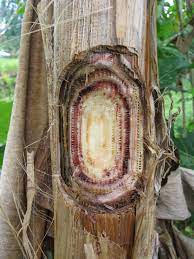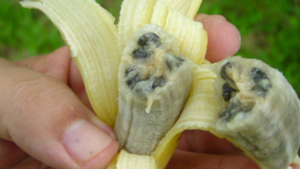Puertego Disease

Puertego disease (or Senla wilt) is a plant disease native to Puertego that infects and kills banana plants. It is a wilting disease caused by a fungus that is resistant to fungicides and which has its control limited to phytosanitary measures. Senla wilt was first discovered in the early 1920s however there have been reports from native Puertegans that the disease go back hundreds of years in their history.
During the 1950s Senla wilt almost completely wiped out banana production in Puertego with the nations farmers having to switch to other more disease resistant banana variants after inflicting enormous costs to the nations farmers and plantation owners and driving many into bankruptcy. Senla wilt remains a large problem to Puertegos banana farms with the speed it spreads and how fast the disease acts making it possible for an outbreak of it to bankrupt farmers over the course of only one to two weeks especially as most have no knowledge of prevention methods used.
History
Reports and myths of Senla wilt are reported to go back hundreds of years with ancient civilizations inhabiting Puertegos modern territory having myths and stories about Senla wilt being a curse from the gods in order to ruin certain farmers. However the disease was not shown to have had any major outbreaks in the early days of Puertegan colonization or the plantation based political system established after independence with this being assumed to be due to the variant of banana being used at the time being highly resistant to the disease, however this changed once production largely switched to the variant called the Miguel Grande due to the much shorter time to grow the plants and the larger yield compared to previous bananas, however the Miguel Grande had very weak almost non-existent resistance to the disease due to it having been bred and cultivated for years in countries that have never had any cases of Senla wilt.

Once the disease started having several large flare-ups across the countries plantations and smaller farms a state of panic both domestically and internationally about the possibility of the disease eradicating or at least severely hampering production of the banana if it spread in , many nations temporarily placed a complete ban on agricultural exports from Puertego with Cartadania almost starting a war with Puertego over the incident when a Puertegan merchant ship that was carrying bananas was fired at and sunk in Cartadaian waters resulting in almost 200 deaths after the ship refused to allow officials to inspect its cargo and tried to sail into port anyway after being ordered to turn around multiple times, after it was discovered that the cargo of the ship did indeed contain produce infected with Senla wilt fears were raised in other countries about the possibility of the disease spreading to their own banana plantations and possibly other plants as well, there were also claims that the government of Puertego was attempting to engage in a form of bio-terrorism and is purposefully sending out infected bananas to other countries to try and damage their production however these claims were vigorously denied and is often considered a conspiracy theory. There were small outbreaks of the disease in other countries around Vallos and Sarpedon and the disease is still present in various countries other than Puertego however none of them have had the disease inflict as much damage as it has in Puertego.
After major outbreaks of the disease stopped in the mid-1960s almost 45,000 hectares of plantation and farm was destroyed in a 12 year period. Afterwards in Puertego with no major outbreaks of the disease reported for years agricultural export bans were lifted and banana exports continued like normal however with more strict quality control implemented. So far there have not been any other outbreaks of Puertego disease as devastating as the one in the 1950s-1960s however the presence of the disease remains constant with primarily small privately owned farms being hit the hardest most often with it. However in the early 2000s it was discovered that the disease has began infecting plantains as well though there has been debate over whether this is a mutation of the original disease or a new strain.
Symptoms


Infections by Senla wilt triggers the self-defense mechanism in plants making the plant secrete gel, this is followed by the formation of tylose in the vascular vessels which blocks the movement of water and nutrients to the upper parts of the plant. Senla wilt continues harming the plant with the signs of infection being small dark spots around the banana with long black streaks on the fruit and leaves being visible shortly after dark spots begin appearing as well as the leaves often splitting down the middle. As the disease progresses more leaves begin to split, discolor, and crumble until eventually the entire canopy of the tree is made of dying leaves with the fruit of the plant beginning to turn black all over at this point. Once the plant if infected recovery is very rare however if it does recover any new emerging suckers will be infected and spread on the disease.
Management efforts
Fungicides are largely ineffective against the disease and there are very few options for managing the Senla wilt. Soil sterilization is a method commonly used primarily involving spraying infected areas with methyl bromide, this is done as the fungus that causes Senla wilt is able to stay dormant in the soil for years however this method is only effective at fighting off the disease for around 3 years in infected areas with re-population of the fungus after this period being common. Injecting infected plants with carbendazim and potassium phosphonate has been shown to slow the infection but not get rid of it completely. So far the greatest hope for preventing infections of the disease is genetic modification of bananas and plantains to be completely resistant to the disease in order to make it die out or at least make the fruits more resistant in order to severely slow infections, so far genetic modification for resistance is still underdeveloped however there have been attempts with no current results available such as a collaboration effort between Puertegan and Caphirian scientists to develop more resistant produce. Lack of effective education on the disease and lack of resources to control and prevent it remain some of the largest problems in stopping the spread of the disease among Puertegos farmers, the government of Puertego has promised it will make an effort into increasing awareness and education about Senla wilt but has so far not done anything tangible to deliver on that promise.